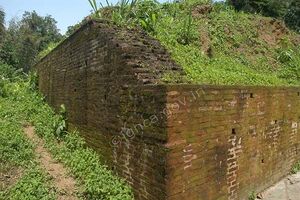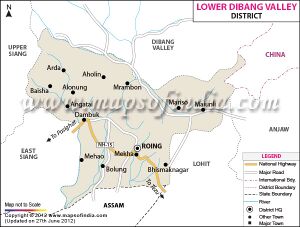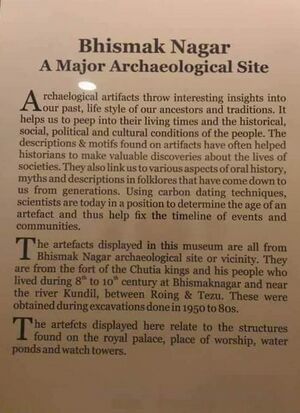Bhismaknagar
| Author:Laxman Burdak, IFS (R) |
Bhismaknagar (भीष्मकनगर) is an important ancient archeological site near Roing in Lower Dibang Valley district in Indian state of Arunachal Pradesh. The site must have been a stronghold of the Chutias. Bhishmaknagar has its link with the Mahabharata's Rukmini, the chief wife of Lord Krishna believed to be from this region. Bishmaknagar is situated 30 km southeast from Roing town.[1]
Variants
- Bhismak Nagar (भीष्मकनगर)
- Bhismakanagara (भीष्मकनगर)
- Bhishmakanagara (भीष्मकनगर)
- Sadiya (सदिया)
- Sadhayapuri (साध्यपुरी)
- Svadhayapuri (स्वाध्यायपुरी)
- Che-lung (चे-लंग) (in Tai Buranjis, meaning "Great City" ).
- Kundila Nagara (कुंडिलनगर) - Being situated on Kundil River
- Sadhyapura (साध्यापुर)
Location
Bhismaknagar is located near Roing in Lower Dibang Valley district.[2] The remains are generally ascribed to the rule of the Chutias, a Bodo-Kachari (Tibeto-Burmese) ethnic group[3] who ruled over the region of Sadiya from 11th to 16th Century CE.[4]
It is located in Dibang Valley district and is a sacred heritage of the Idu Mishmis. It is a symbol of past glory and indicate the high standard of civilisation that once prevailed around Bhismaknagar. Bhismaknagar must have been a strong hold of the Chutiyas (12th-16th centuries) but the excavations has been throwing new light on its much earlier antiquities. Bhismaknagar stands for what is best in the tribal and Aryans way of life. It speaks for the Catholic spirit of the ancient Indians and the contribution made by the Idus to the synthetic fabric of Indian culture. Today Bhismaknagar has become the nucleus of a renaisance a determination of a sturdy race to revive its traditional culture, while accepting everything that is progressive.[5]
Etymology
The name Bhismaknagar was first observed in the Assam District Gazetteer of the year 1928[6]—reference to a work by the 16th-century seer Sankardev that was popular in the Sadiya region (which eventually found its way into the later Chutia chronicles.)
Historically, the region was known as Sadhayapura (the rulers being Sadhayapur-ishwar) as per copper inscriptions[7] and the fort formed part of the capital region of the Chutia king Laksminarayana,[8]also known as Che-lung in Tai Buranjis (meaning "Great City" in English).
Jat clans
- Kundu - Kundila (कुंडिल)- A city named Kundila is mentioned in Mahabharata, the inhabitants of this were known as Kundu. They are also mentioned as descendants of rishi Kondilya (कोंडिल्य).[9] Kundu is a Jat clan.
History
Bhismaknagar is an important ancient archeological site. The site must have been a stronghold of the Chutias. The ruins have been dated between the 11th-15th centuries.[10] Bhismaknagar has been identified with Sadhayapuri (or Svadhayapuri), the political centre of the Chutia Kingdom.[11]Based on insription of bricks, it is assumed to be the capital of Chutia king Lakṣmīnārāyaṇa of the early fifteenth century. The paleographical analysis of the inscription supports this dating.[12]
Bhishmaknagar has its link with the Mahabharata. Rukmini, the chief wife of Lord Krishna was believed to be from this region. However, there is no evidence of their existence but the ruins (plinth) of the fort remains and are proof to some really great history of the region. Bishmaknagar is situated 30 km southeast from Roing town.[13]
Architecture
The fort, with its fortifications and buildings, is built of fired bricks. The fortified city is spread over an area of 10 square km. The wall is 4.5 meters high and 6 meters wide, made using granite stone (6-9 courses)[14][15] and bricks on the east, west and south directions. In the north, the Mishmi hills provided a natural barrier. Although very less excavation has been carried out by the Arunachal government, preliminary excavations have revealed three tanks and two gates in the eastern and western directions.[16]
The Bhismaknagar central complex extended over an area of 1860 square meters and displays three halls, six ingresses and two extension rooms. There is also a 2 meters high stone wall inside the complex. The architecture of the fort displays the medieval culture. While quarrying the fort the enormous pieces of work of art like potteries, terracotta figurines, terracotta plaques and decorative tiles were preserved.[17]
Legacy
The Ahom kingdom took complete possession of the royal insignia and other assets of the erstwhile kingdom. Besides, the items of Chutiya aristocracy like the Danda-Chhatra (royal umbrella), Arwan, Kekura-dola (Palaquin), embroidered-japi etc. were adopted by the Ahoms. The Chutiya kingdom had also several salt-springs at places like Borhat, which came under the Ahoms after its annexation [18] The rest of the royal family was dispersed, the nobles were disbanded and the territory was placed under the newly created office of the Sadiakhowa Gohain.[19]] Besides the material assets and territories, the Ahoms also took possession of the people according to their professions. Many of Brahmans, Kayasthas, Kalitas, and Daivajnas (the caste Hindus), as well as the artisans such as bell-metal workers, goldsmiths, blacksmiths, and others, were moved to the Ahom capital and this movement greatly increased the admixture of the Chutia and Ahom populations.[20]A sizeable section of the population was also displaced from their former lands and dispersed in other parts of Upper Assam.[21]
After annexing the Chutia kingdom, offices of the Ahom kingdom, Thao-mung Mung-teu (Bhatialia Gohain) with headquarters at Habung (Lakhimpur), Thao-mung Ban-lung (Banlungia Gohain) at Banlung (Dhemaji), Thao-mung Mung-klang(Dihingia gohain) at Dihing (Dibrugarh, Majuli and northern Sibsagar), Chaolung Shulung at Tiphao (northern Dibrugarh) were created to administer the newly acquired regions.[22]
Bhishmaka of Mahabharata
Bhishmaka (भीष्मक) was the king of Vidarbha. Bhishmaka was father of Rukmi, the elder brother of Rukmini. Rukmini married with Krishna.
Bhismaka (भीष्मक) Mahabharata (II.28.10)/(2-32-13a), (II.28.41)
Sabha Parva, Mahabharata/Book II Chapter 28 mentions Sahadeva's march towards south: kings and tribes defeated. Bhismaka (भीष्मक) is mentioned in Mahabharata (II.28.10)/(2-32-13a).[23].....After Avanti, the hero (Sahdeva) marched towards the town of Bhojakata, and there, O king of unfading glory, a fierce encounter took place between him and the king of that city for two whole days. But the son of Madri (Sahdeva), vanquishing the invincible Bhismaka, then defeated in battle the king of Kosala and the ruler of the territories lying on the banks of the Venwa, as also the Kantarakas and the kings of the eastern Kosalas.
Sabha Parva, Mahabharata/Book II Chapter 28 mentions Bhismaka (भीष्मक) in Mahabharata (II.28.41).[24] And the prince (Sahdeva), after Mahishmati, with great efforts brought Ahriti, the king of Surashtra and preceptor of the Kausikas under his sway. The virtuous prince, while staying in the kingdom of Surashtra sent an ambassador unto king Rukmin of Bhishmaka within the territories of Bhojakata, who, rich in possessions and intelligence, was the friend of Indra himself. And the monarch along with his son, remembering their relationship with Krishna, cheerfully accepted, O king, the sway of the son of Pandu. And the master of battle then, having exacted jewels and wealth from king Rukmin, marched further to the south.
Kundala in Mahabharata
- Kundala (कुण्डल) (Naga) in Mahabharata (I.52.12), (I.57), (I.89.51), (1.94),
- Kundala (कुण्डला) (River) in Mahabharata (VI.10.20),
भीष्मकनगर
भीष्मकनगर भारत के अरुणाचल प्रदेश राज्य के निचली दिबांग घाटी ज़िले में स्थित एक पुरातत्व स्थल है। यह रोइंग के समीप स्थित है। भीष्मकनगर नाम शोधकर्ताओं द्वारा गढ़ा गया था जिन्होंने 1970 के दशक में खंडहरों की खोज की थी। इसका नाम शायद चुटिया के एक महान राजा भिरमुक्का के संस्कृतीकरण के परिणामस्वरूप रखा गया था । मध्ययुगीन चुटिया साम्राज्य के संस्थापक बिरंजिस के अनुसार, खुद को राजा भृमुक्का का वंशज कहा। देवदई बुरांजी लिखता है...
- "सादिया कोरजाकु-देश छुटिका-बंशा भिरुमक्का
- धतु द्रव्य तू लेबे न हटवा जनपदनया" 185 "....चुटिया वंशावली, देवढई बुरनजी [25]
ऐतिहासिक रूप से कुंडिल-नगर नाम से लोकप्रिय (कुंडिल नदी के तट पर स्थित होने के कारण), साध्यापुर (शासक साध्यापुर-ईश्वर) और ताई बुरांजी में चे-लंग (असम में बार-नगर और अंग्रेजी में ग्रेट सिटी) के रूप में जाना जाता था। यह लोअर दिबांग घाटी जिले में स्थित है। पुराने शहर का परिसर 2500 एकड़ के क्षेत्र में फैला हुआ है।
इतिहास: भीष्मकनगर एक महत्वपूर्ण प्राचीन पुरातत्व स्थल है। भीष्मकनगर चुटिया लोगों का गढ़ रहा होगा। खंडहर 11वीं-15वीं शताब्दी के बीच के हैं। भीष्मकनगर की पहचान चुटिया साम्राज्य के राजनीतिक केंद्र साध्यपुरी (या स्वाध्यायपुरी) से की गई है । शिलालेख के आधार पर, इसे पंद्रहवीं शताब्दी की शुरुआत के चुटिया राजा लक्ष्मणनारायण की राजधानी माना जाता है।
आर्किटेक्चर: इसे पक्की ईंटों से बनाया गया है। यह शहर 10 वर्ग किमी के क्षेत्र में फैला हुआ है। यह ग्रेनाइट पत्थर और पूर्व, पश्चिम और दक्षिण दिशाओं में ईंटों का उपयोग करके 4.5 मीटर ऊंची और 6 मीटर चौड़ी दीवार से घिरा हुआ है । उत्तर में, मिश्मी पहाड़ियों ने एक प्राकृतिक अवरोध प्रदान किया। यद्यपि अरुणाचल सरकार द्वारा बहुत कम उत्खनन किया गया है, प्रारंभिक खुदाई में पूर्वी और पश्चिमी दिशाओं में तीन टैंक और दो द्वार का पता चला है।
भीष्मकनगर केंद्रीय परिसर 1860 वर्ग मीटर के क्षेत्र में फैला हुआ है और तीन हॉल, छह प्रवेश द्वार और दो विस्तार कक्ष प्रदर्शित करता है। परिसर के अंदर 2 मीटर ऊंची पत्थर की दीवार भी है। किले की वास्तुकला मध्यकालीन संस्कृति को प्रदर्शित करती है। किले की खुदाई के दौरान मिट्टी के बर्तनों, टेराकोटा मूर्तियों, टेराकोटा पट्टिकाओं और सजावटी टाइलों जैसी कला के विशाल कार्यों को संरक्षित किया गया था।
भीष्मकनगर किला
भीष्मकनगर, अरूणाचल प्रदेश का एक लोकप्रिय पुरातत्व और धरोहर स्थल है। इस जगह की लोकप्रियता का प्रमुख कारण यहां स्थित भीष्मकनगर किला है जो रोइंग से लगभग 30 किमी. की दूरी पर स्थित है। इस किले को 8 वीं सदी में जली हुई ईटों से बनाया गया था और यहा किला, राज्य के सबसे पुराने पुरातात्विक किलों में से एक है। यह स्थल अरूणाचल प्रदेश के जनजाति समुदाय इदु मिस्मीस के लिए एक पवित्र धरोहर है। इस स्थल की खुदाई पर यहां कई कलाकृतियां पाई गई जिनमें मिट्टी के सजावटी सामान, सजावटी टाइल्स, मिट्टी की मूर्तियां और बर्तन आदि शामिल थे। [26]
संवेद्य
संवेद्य (AS, p.929) नामक प्राचीन तीर्थ का उल्लेख महाभारत, वनपर्व 85,1 में हुआ है- 'अथ संध्यां समासाद्य संवेद्यं तीर्थमुनमम् उपस्पृश्य नरोविद्यां लभते नात्र संशयः।' अर्थात 'संध्या के समय श्रेष्ठ [p.930]: तीर्थ संवेद्य में जाकर स्नान करने से मनुष्य की विद्या को लाभ होता है, इसमें संदेह नहीं है।' इस तीर्थ का अभिज्ञान सदिया (बंगाल) से किया गया है। संवेद्य के आगे महाभारत, वनपर्व 85, 2-3 में लौहित्य और करतोया का उल्लेख है।[27]
External links
References
- ↑ https://roing.nic.in/places-of-interest/
- ↑ Among many works of Śankaradeva, the Rukmiṇiharaṇa, the poem of Rukmimi and Krishna, gained considerable popularity in the Sadiya area and influenced its regional identity construction. Rukmiṇī, in this poem, was a daughter of king Bhīṣmaka. The Bhīṣmaka lineage became a part of the new literary tradition of the region and eventually found its way into the later Chutiya chronicles.
- ↑ [1]
- ↑ http://asiguwahaticircle.gov.in/bhismaknagar.html Remains at Bhismaknagar (ASI official website), "The remains are generally ascribed to he rule of the 'Chutias', a Tibeto-Burmese tribe who ruled over the region of Sadiya from 11th to 16th Century CE."
- ↑ http://arunachalpradesh.gov.in/bnagar.htm
- ↑ "Again at Bishemnagar or Bishmuknagar, situated near Chipulin village up the Balijan (Sunpura) river and accessible from mile 27 on the Lohit valley road, is the remains of a large fort and settlement. It is supposed to have been built by Raja Bishmook or Bhikrum, Raja of Kundilpur, father of Rukmini."(C. Allen 1928:19):C. Allen, B (1928). Assam district gazetteers. Vol. XI. Baptist Mission Press.
- ↑ Shin, Jae-Eun (2020). "Descending from demons, ascending to kshatriyas: Genealogical claims and political process in pre-modern Northeast India, The Chutiyas and the Dimasas". The Indian Economic and Social History Review. 57 (1): 49–75. doi:10.1177/0019464619894134. S2CID 213213265.p.52
- ↑ "The ruins of two forts in Lohit district of Arunachal Pradesh are said to be the remains of Bhīṣmaka’s city, viz. Bhismaknagar (sk. Bhīṣmakanagara): one ruin about 16 miles northwest of Sadiya at the foot of the hills between the rivers Dikrang and Dibang is known as the fort of Bhīṣmaka, and the other about 24 miles north of Sadiya between the gorges of those two rivers is believed to be the fort of Śiśupāla. Based on an inscribed brick with the name of Śrī-śrī-Lakṣmīnārāyaṇa, discovered from the ruins of the forts in Bhismaknagar, it is assumed that Chutiya king Lakṣmīnārāyaṇa of the early fifteenth century had his capital in the area. The paleographical analysis of the inscription supports this dating." (Shin 2020:56)
- ↑ Mahendra Singh Arya et al.: Adhunik Jat Itihas, Agra 1998, p. 229
- ↑ Tada, Tage; Dutta, J. C.; Deori, Nabajit (2012). Archaeological Heritage of Arunachal Pradesh. Government of Arunachal Pradesh, Department of Cultural Affairs, Directorate of Research.p.8
- ↑ Momin, Mignonette; Mawlong, Cecile A.; Qādrī, Fuz̤ail Aḥmad (2006). Society and Economy in North-East India. Regency Publications. ISBN 9788189233402.p.47
- ↑ Based on an inscribed brick with the name of Śrīśrī-Lakṣmīnārāyaṇa, discovered from the ruins of the forts in Bhismaknagar, it is assumed that Chutiya king Lakṣmīnārāyaṇa of the early fifteenth century had his capital in the area. The paleographical analysis of the inscription supports this dating (Shin 2020, p. 56)
- ↑ https://roing.nic.in/places-of-interest/
- ↑ Gait, Edward. A history of Assam(2nd Edition). 1962, p. 16.
- ↑ Tada 2011, p. 114.
- ↑ A. Raikar, Yashavant (1980). Archaeology in Arunachal Pradesh. Directorate of Research, Govt. of Arunachal Pradesh.p.19
- ↑ Tada, Tage (2011). Archaeological remains of Arunachal Pradesh up to 16th century (Ph.D.). Rajiv Gandhi University. hdl:10603/288770.p. 114
- ↑ Dutta, Sristidhar (1985), The Mataks and their Kingdom, Allahabad: Chugh Publications,p.30
- ↑ Baruah, S L (1986), A Comprehensive History of Assam, Munshiram Manoharlal, p. 229.
- ↑ Baruah 1986, p. 230.
- ↑ (Shin 2020:53)
- ↑ (Gait 1963:8)
- ↑ स विजित्य दुराधर्षं भीष्मकं माद्रिनन्दनः। (2-32-13a) कोसलाधिपतिं चैव तथा वेणातटाधिपम्।। (2-32-13b)
- ↑ सुराष्ट्र विषयस्दश च परेषयाम आस रुक्मिणे, राज्ञे भॊजकटस्दाय महामात्राय धीमते (II.28.41) भीष्मकाय स धर्मात्मा साक्षाथ इन्थ्र सखाय वै, स चास्य ससुतॊ राजन परतिजग्राह शासनम (II.28.41)
- ↑ Wikipedia site:hi.tr2tr.wiki
- ↑ https://hindi.nativeplanet.com/roing/attractions/bhismaknagar/
- ↑ Aitihasik Sthanavali by Vijayendra Kumar Mathur, p.929-930


